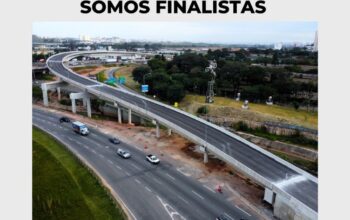
Do ponto de vista da execução dos corredores, a grande questão não será de técnica e sim de gestão: como implantá-los numa cidade tão adensada? O projeto de construção de um corredor de ônibus poderia parecer relativamente simples, mas no traçado das ruas paulistanas ele se complica.
“É que temos de trabalhar com a variável que é a desapropriação. E ela não é simplesmente como se fazia no passado, quando se decretava e o proprietário ficava com o ônus da história. Isso evoluiu muito”, explica Roberto Moura, responsável pela superintendência de detalhamento de projetos e de meio ambiente da SPTrans, empresa que gerencia o transporte público em São Paulo.

Segundo ele, a exemplo de toda intervenção em área urbana, a do corredor terá que lidar com a própria complexidade do seu entorno e suas múltiplas interferências no trajeto. “Cada quilômetro que avança tem novos problemas, a questão das conexões que a gente imagina, ora com a CPTM, ora com o metrô, ora com a Sabesp, com a Petrobras, com a própria prefeitura e seus novos projetos. O grande número de variáveis é que torna esse projeto bastante peculiar e complexo”, define o dirigente da SPTrans.
Características dos novos corredores de ônibus
Piso de pavimento rígido (concreto) em toda extensão
Cobrança desembarcada (feita fora do veículo)
Enterramento de cabos, com rebaixamento das redes
Alargamento de vias
Nova iluminação pública
Faixa exclusiva para ônibus de até 3,20 m, com faixa adicional para ultrapassagem nas plataformas, por sentido
Duas faixas de tráfego geral (3 m) por sentido
Fonte: SPTrans
Bottura: “É preciso identificar a causa”
O engenheiro Luiz Célio Bottura, que já foi presidente da Dersa e ombudsman da cidade, acha que o transporte da capital e de sua região metropolitana precisa ser revolvido com medidas efetivas, como a criação de corredores de transporte (metrô, trem, ônibus) que constituam também intervenções urbanísticas no entorno. E tudo executado pela iniciativa privada, com a incorporação de áreas e não desapropriação.
Leia a seguir trechos da entrevista com o engenheiro, realizada no escritório dele, na Zona Sul de São Paulo:
A origem da causa
“Em primeiro lugar, a gente precisa saber identificar a origem da causa. Não adianta trabalhar na consequência. O sintoma é que nos assusta. E o que é um sintoma? O congestionamento é um, o ônibus cheio é um, o ônibus demorando é outro, a passeata na rua é a explosão do sintoma. Daí, nós não vamos para o diagnóstico, não vamos saber por que está acontecendo aquilo, já saímos para soluções caseiras, de algibeira. Para um sintoma, se tem um diagnóstico. E se tem que procurar um remédio criado especificamente ou de farmácia. Mas todo remédio tem efeito colateral. Se não tomar cuidado com o efeito colateral, a sequela é maior do que os benefícios.

Precisamos ter a capacidade de ver antecipadamente os efeitos colaterais e, aí, fazer as mitigações. No transporte público, também vemos assim. Então qual é a origem dos nossos problemas? Genericamente, está na formação da cidade. Ela foi muito mal arranjada e passou por arranjos políticos imediatistas. Por exemplo, a lei da anistia aos loteamentos irregulares e às obras públicas e privadas irregulares, os planos diretores que não são nem sequer controlados, quanto mais respeitados, os orçamentos que são de brincadeira. Se faz um orçamento e se diz que o governo pode mexer em 20% dele, mas o investimento é de 4%, 5%. Então, se eu posso mexer em 20%, posso mexer no que eu quero. O orçamento público tem que se tornar obrigatório. Não pode mexer. Bom administrador é aquele que souber administrar um orçamento o melhor possível.
O metrô segue a mesma linha. Está fazendo uma série de obras, de empreendimentos ao longo da linha e quem vai ganhar é o privado. Vai ter shopping, valorização, apartamentos etc. Por que isso não pode ser investido pelo privado, para fazer empreendimentos e recuperar parte do dinheiro? Por que o metrô não pode ficar dentro de um empreendimento, num shopping? O metrô poderia ser uma central de transporte dentro de um empreendimento imobiliário.”
(Guilherme Azevedo)
English Version
Bus-exclusive lanes and corridors
The assessment – and the proposal for increasing the number of exclusive corridors – seems to be synchronized with the idea put into practice by mayor Fernando Haddad (PT), who has prioritized transportation by bus, which is supposed to have preference in the fight for space on the streets against private cars, as suggests, by the way, the law that created the National Plan of Urban Mobility in force since April last year. The prefecture has implemented projects to build more bus-exclusive corridors and, at the same time, to speed up the implementation of more bus-exclusive lanes on the main streets in the city.
By 2016 the promise is to deliver more 150km of new corridors and 16 terminals, with of over R$6 billion investments. A tender for 68.5km of corridors to be held by the Municipal Department of Infrastructure and Construction Work, which was created in the previous government, is at its final phase and the construction work is expected to start still this year. Another tender for more 147km (out of which 80km should be delivered until the end of the current governor’s term, in 2016), developed by the Municipal Department of Transportation, in undergoing its fi
nal phase of modeling and it is expected to end still this semester so that the construction starts at the beginning of next year. The new corridors will essentially benefit the population leaving the eastern and southern regions, those with the highest number of inhabitants. Today São Paulo city has ten bus-exclusive corridors totaling 119.7 km. With the addition of the 150km promised, it will be about 270km long. And in the plans of the current mayor, by 2025 São Paulo will have 460km of bus-exclusive corridors.
Another action taken to improve the situation of urban mobility in the city targeting on gaining speed (and quality) in a ride by bus is the “Give preference to the bus” campaign, aimed at prioritizing the traffic of public transportation. Over 80km of bus-exclusive lanes have already been implemented (July) and the goal is to reach a total of 220km by the end of this year. Some of the main streets in the Capital City already have bus-exclusive lanes at peak hours, such as the Pinheiros and Tiete marginal roads and Paulista Avenue. The general objective of the mayor, expressed in the Objective 16 of the 2013-2016 Program of Goals, a document containing 100 goals which is the consolidation of Haddad’s plan of government, is to “increase the area with exclusive circulation and qualify the municipal bus system, increasing the average speed at peak hours from 14km/h (Aug/2012) to 25km/h”. The city of São Paulo today has (June 2013) a 15,046 bus fleet (a virtually stable figure for the last years) distributed into 1,318 bus lines. According to SPTrans’ accounts, 4.5 million on average of the so-called “Bilhete Único” (Single Ticket) are recorded in the municipal transportation system, which stands for 6 million trips and 9.8 million passengers every business day.
A management work
Under the point of view of executing the corridors, the big issue will not be technical, but management: how to implement them in such a populated city? The construction project of a bus-exclusive corridor may seem relatively simple, but when dealing with the design of the streets in the city, things get confusing.
“Trouble is we have to work with the variable of expropriation. And it is not the same as it used to be in the past, when an expropriation order would be issued and the owner had to deal with all burdens involved. That has evolved a lot”, explains Roberto Moura in charge of the superintendence of project detailing and environment with SPTrans, the company that manages public transportation in São Paulo.
According to him, as any intervention in urban areas, corridors will have to deal with the very complexity of the surrounding areas and their multiple interferences in the route. “Each kilometer that makes some headway faces new problems, the issue of connections that are well known, sometimes with the CPTM, sometimes with the subway, with Sabesp, with Petrobras, with the very prefecture and its new projects. The large number of variables is what makes this project rather peculiar and complex”, defines SPTrans administrator.
Characteristics of the new bus-exclusive corridors
Hard-paved floor (concrete) in their whole length; tickets charged before boarding; buried cables and lowered networks; increasing streets’ width; new public lighting; bus-exclusive lanes of up to 3.20m, with an additional lane for over passing at platforms at each direction; two local lanes for general traffic (3m) at both direction.
Bottura: “We have to identify the cause”
Engineer Luiz Celio Bottura, former president of Dersa and ombudsman of the city, thinks that transportation in the capital city and its metropolitan region needs to be solved with effective actions, with the creation of transportation corridors (subway, train, bus) also able to be urban interventions in the surrounding areas. And everything should be executed by the private initiative with the incorporation of areas instead of expropriation.
Origin of the cause
“Firstly, we have to know how to identify the origin of the cause. It is not worth working on consequences. The symptom is scary. And what is the symptom? Traffic jams, crowded buses, long time waiting for a bus, and the protests on the streets is the explosion of the symptom. Then we should not go to the diagnosis, we do not know why that is happening, we have already left domestic solutions, simplistic ones. For each symptom there is a diagnosis. And we have to look for a medicine specifically designed or an over-the-counter one. But all medicines have side effects. If you are not careful about side effects, the damage is bigger than the benefit.
We have to be able to see side effects in advance and then mitigate them. In public transportation we also see things like that. Then, which is the origin of our problems? Generally speaking, it is in the formation of the city. It was very badly arranged and it suffered short-sighted political actions. For instance, the law of amnesty to irregular developments and irregular public and private developments, directive plans that are not even controlled, let aside being respected, and budgets that are a joke. A budget is done and it is said that the government can make changes in 20% of it, but the investment actually made is 4%, 5%. Then, if you can change 20%, you can change whatever you want. A public budget has to be mandatory. No one can change it. A good administrator is someone who knows how to manage a budget as well as possible.
The subway follows the on same track. A number of construction work has been done, undertakings along the line and the winner will be the private sector. There will be shopping malls, valuation, apartments, etc. That is why investments cannot be made by the private sector, i.e., implementing undertakings and recovering part of the money? Why can’t the subway be inside an undertaking, a shopping mall? The subway could be a center of transportation inside a real-estate development.
(Guilherme Azevedo)
Fonte: Revista O Empreiteiro







